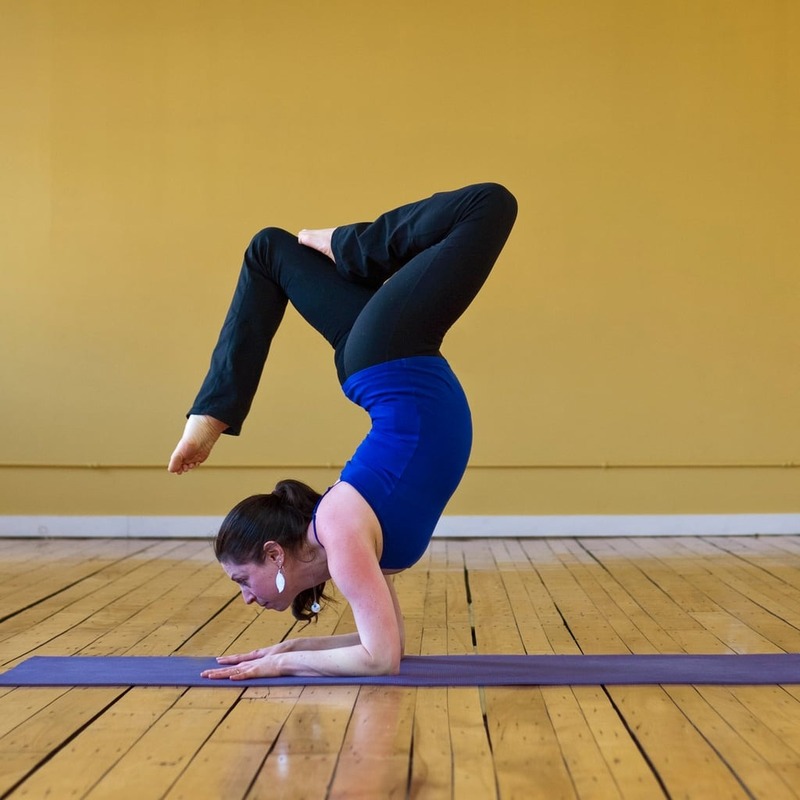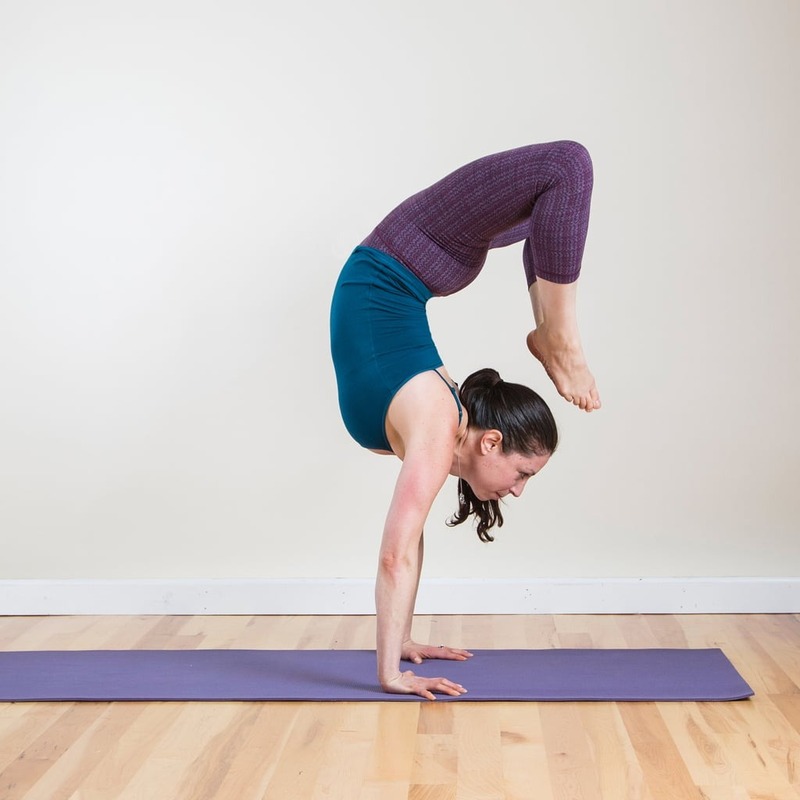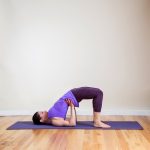Introduction to Yoga Scorpion Pose
Yoga Scorpion Pose, or Vrischikasana, is an advanced yoga asana. This pose symbolizes the journey of strength, balance, and grace in yoga practice. Its execution demands a mix of flexibility, core strength, and mental focus. When performed correctly, it resembles a scorpion with its tail arched over its back. Scorpion pose is not just about physical prowess. It also represents inner transformation and control attainable through dedicated practice. It’s a challenging posture offering diverse benefits. These include improved balance, spine flexibility, and concentration. Preparing for scorpion pose requires careful warm-ups and a step-by-step approach. This guide will help you build the required strength and flexibility. We will cover the pose’s origins, the muscles involved, preparatory poses, and safety tips. Also, we will address common mistakes to avoid and answer frequently asked questions. Our guide aims to help you safely embrace the challenge of scorpion pose yoga.
Origins and Significance of Yoga Scorpion Pose
In the rich tapestry of yoga, the Yoga Scorpion Pose stands out for its depth of meaning. In Sanskrit, ‘Vrischikasana’ translates directly to “scorpion pose,” capturing the essence and form of the creature it is named after. With its tail poised overhead, ready to strike, it’s a visual reminder of focus, control, and power. This challenging pose hails from traditions centuries old and is a testament to the unity of mind, body, and spirit. Scorpion Pose is often seen as a peak posture, denoting a high level of achievement in yoga practice. It’s not merely about bending and balance but also inner strength and courage.
Those who pursue it find that its rewards are more than just physical; they are deeply spiritual too. It embodies transformation, as the yogi harnesses discipline to elevate their practice. Moreover, Scorpion Pose’s significance stretches into the metaphysical realm, representing the ability to manage life’s poisons—challenges and setbacks—much like the scorpion wields its venom. A symbol of alert readiness, this pose encourages practitioners to face obstacles with grace and poise. In essence, Vrischikasana is much more than an asana; it’s a journey into the self, an exploration of potential, and a dialogue with the divine.

Anatomical Focus: Understanding the Muscles Involved
Yoga Scorpion Pose is a challenging asana. It targets multiple muscle groups and requires a blend of strength and flexibility. Here’s an anatomical breakdown of the key muscles engaged in Scorpion Pose:
- The shoulder muscles, including the deltoids and rotator cuff, provide stability for the arms.
- Arm muscles, like the biceps and triceps, support the body’s weight during the inversion.
- The chest muscles, particularly the pectoralis major, help in maintaining the pose.
- Back muscles, including the latissimus dorsi and trapezius, are stretched and strengthened.
- Core muscles, such as the transversus abdominis and obliques, are vital for balance.
- Hip flexors and quadriceps guide the legs towards the head.
Understanding these muscles aids in safely mastering the pose. Flexibility in the spine and hips is just as crucial as strength in the upper body. Gateway poses to develop these areas include Dolphin Pose and Camel Pose. Incorporating these into your routine ensures the necessary conditioning. Regular, mindful practice of Scorpion Pose fosters balance between muscle strength and joint flexibility. It also promotes overall body awareness and alignment.
Preparatory Poses for Scorpion Pose Yoga
Embarking on scorpion pose yoga requires prior preparation. The right preparatory poses help build the needed strength and flexibility. Here are some recommended poses:
- Dolphin Pose: Strengthens shoulders and opens the upper back. A must for arm balance.
- Forearm Plank: Builds core and arm strength, teaching stability needed for scorpion pose.
- Camel Pose: Opens the chest and hips, mirroring the backbend in scorpion pose.
- Cobra Pose: Increases spine flexibility, vital for the deep backbend in scorpion pose.
- Bridge Pose: Works as a gentle backbend, preparing the body for more intense arching.
Practicing these poses regularly will lead to progress. Focus on form and be patient. Gradually, your body will be ready for the intricate balance and strength of scorpion pose. Always listen to your body and modify if needed. Remember, rushing can cause injuries. Take your time and respect your body’s signals.
Step-by-Step Guide to Entering Scorpion Pose
Achieving the Scorpion Pose, or Vrischikasana, is a journey that requires patience and perseverance. Here’s a simplified, step-by-step guide to help you enter the pose with correct form and mindful execution:
- Start in Forearm Stand: Establish your base in Pincha Mayurasana (Forearm Stand) with your elbows shoulder-width apart and forearms grounded.
- Engage Your Core: Activate your abdominal muscles to provide stability and support your spine as you balance.
- Shift Your Hips: Gently push your hips forward to start the backbending process necessary for Scorpion Pose.
- Arch Your Back: Introduce a slight backbend while keeping your core engaged to protect your lower back.
- Bend Your Knees: Once balanced, slowly bend your knees and aim your toes toward your head, resembling a scorpion’s tail.
- Maintain Shoulder Stability: Keep your shoulders strong and steady to support the weight of your body.
- Adjust Your Gaze: Shift your focus slightly forward to assist with balance and deepen the pose.
- Deepen the Backbend: Continue to arch your back, reaching your feet closer to your head as far as your flexibility allows.
- Breathe and Hold: Focus on your breathing to maintain the pose, holding for a few seconds up to a minute as you gain proficiency.
- Exit Safely: To release, straighten your legs back up into Forearm Stand before lowering them down and resting in Child’s Pose.
Remember to always perform Scorpion Pose progressively, never forcing your body into the posture. It’s about gradual improvement, respecting the limits of your flexibility and strength at every session.
Safety Tips and Modifications for Scorpion Pose
Entering the Scorpion Pose, or Vrischikasana, requires care to avoid injury. Here are some safety tips:
- Warm Up Thoroughly: Start with preparatory poses to gradually open the body.
- Use Props: A wall can aid balance. Blocks can help with alignment.
- Spotting: Have a skilled person assist you the first few times.
Modifications help achieve progress without strain:
- Use a Wall: Practice Scorpion Pose against a wall for support.
- Straps: Wrapping a strap around your upper arms helps keep them aligned.
Avoid these common errors:
- Don’t rush; build strength and flexibility over time.
- Avoid collapsing in the shoulders; keep them engaged.
- Don’t neglect your core; it’s key for balance and support.
Respect your body and practice regularly for the best results. These tips will create a safer practice and ease your journey into Scorpion Pose.

Common Mistakes and How to Avoid Them
When delving into the Scorpion Pose, common errors can hinder progress and risk injury. Here’s how you can steer clear of them:
Overarching the Back
This can strain the lumbar spine, causing discomfort. Instead, engage your core to evenly distribute the curve along the spine.
Neglecting Shoulder Engagement
Failing to activate your shoulders can lead to collapse. Keep them pressed away from your ears, maintaining a strong base.
Rushing Into the Pose
Rushing may lead to improper form. Take it slow, ensuring a gradual build-up of strength and flexibility.
Poor Foundation
A shaky foundation can make the pose unstable. Work on grounding through your forearms and keeping your elbows at shoulder width.
Forgetting to Breathe
Holding your breath creates tension. Breathe deeply to stay calm and centered, this aids in maintaining balance.
Neglecting Leg Activation
Inactive legs can cause sagging hips. Keep your legs energized, reaching actively through your toes.
Avoid these common mistakes by practicing regularly with focus on form and alignment. This will lead to a safer, more effective Scorpion Pose practice.
The Transformative Benefits of Practicing Scorpion Pose
Practicing Scorpion Pose, or Vrischikasana, offers diverse benefits that extend beyond physical health. These transformative effects touch on every dimension of a yogi’s life. Here are the key benefits of regularly practicing this asana:
- Enhances Spinal Flexibility: Regular practice leads to a more flexible back. Gradual backbends prepare your spine to achieve this pose’s depth.
- Builds Strength: Arms, shoulders, and core muscles gain strength. Supporting your body weight cultivates power in these areas.
- Improves Balance: Balancing in this inverted pose sharpens your focus. Over time, you become steadier in mind and body.
- Boosts Concentration: Staying poised in Vrischikasana requires mental clarity. Concentration skills developed here spill into daily life.
- Elevates Mood: Inversions like Scorpion Pose can uplift spirits. They encourage blood flow to the brain, refreshing your outlook.
- Promotes Heart Opening: Chest opens up, encouraging deep breathing. This physical opening mirrors an emotional release, offering stress relief.
- Enhances Coordination: A balance of flexibility and strength ensures smooth movement. Mastering this asana means your body works in harmony.
- Fosters Patience: Learning Scorpion Pose takes time. Patience developed through practice is beneficial in all aspects of life.
- Cultivates Discipline: Progressing into the pose teaches self-discipline. This quality is valuable for personal growth and achieving goals.
Remember, while these benefits are attractive, safety in practice is essential. Always listen to your body, use modifications if necessary, and do not push beyond your limits.

FAQs and Additional Tips for Scorpion Pose Yoga
How often should I practice Scorpion Pose?
Aim to practice a few times a week, increasing frequency as you gain strength and flexibility.
What are some good warm-up exercises for Scorpion Pose?
Try Dolphin Pose, Forearm Plank, and gentle backbends to prepare.
Can beginners attempt Scorpion Pose?
Beginners should master basic yoga and build strength before attempting Scorpion Pose.
What should I do if I feel pain while in Scorpion Pose?
If you feel pain, especially in your back or shoulders, gently exit the pose and rest.
What can I do to improve balance in Scorpion Pose?
Focus on core engagement and practice balancing exercises, like handstand and forearm stand.
Are there any health conditions that should avoid Scorpion Pose?
People with high blood pressure, back injuries, or during pregnancy should avoid this pose.
How can I deepen my Scorpion Pose?
With consistent practice, work on increasing back flexibility and arm strength.
Can practicing Scorpion Pose make me a better yogi?
While it can increase your physical abilities, being a “better yogi” also includes mindfulness and discipline.
Remember to always listen to your body. Use props and modifications as needed. Never rush the process, and enjoy your journey in mastering Scorpion Pose Yoga. Namaste!
Conclusion: Embracing the Challenge of Scorpion Pose Yoga
Vrischikasana, or Scorpion Pose, represents the pinnacle of one’s yoga journey, demanding a blend of strength, flexibility, and focus. It is a symbol of transformation and inner strength, echoing yoga’s profound legacy and the ability to overcome life’s challenges with grace and poise. The complexity of Scorpion Pose serves as a metaphor for life’s journey, teaching us to approach obstacles with alert readiness and confidence.
Through regular practice, you can enjoy the myriad of transformative benefits Scorpion Pose has to offer—enhanced spinal flexibility, increased strength, improved balance and concentration, and a deeper sense of discipline and patience. As you develop your practice, these physical achievements will reflect inwardly, bringing balance to your mind and spirit, along with a boost in mood and coordination skills. This pose is not just about attaining a physical stance but about embodying the resilience, control, and harmony between mind, body, and spirit.
As you proceed on your Scorpion Pose journey, remember to listen to your body and progress at your own pace. Use the preparatory poses to build a strong foundation and employ the provided safety tips to avoid common mistakes. With patience and perseverance, you can master this intricate asana, reaping the benefits on and off the mat.
Whether you’re a beginner taking your first steps or an experienced yogi deepening your practice, embrace the challenge of Scorpion Pose. Remember, the essence of being a yogi isn’t just about physical postures—it’s about cultivating mindfulness, discipline, and self-awareness. Keep these principles at heart, and let Scorpion Pose elevate your yoga practice to new heights. Namaste!


